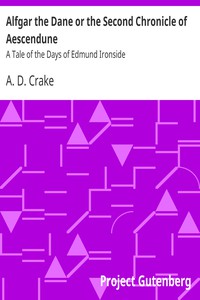Alfgar the Dane or the Second Chronicle of Aescendune<br />A Tale of the Days of Edmund Ironside by A. D. Crake (books like harry potter .TXT) 📕

Read free book «Alfgar the Dane or the Second Chronicle of Aescendune<br />A Tale of the Days of Edmund Ironside by A. D. Crake (books like harry potter .TXT) 📕» - read online or download for free at americanlibrarybooks.com
- Author: A. D. Crake
Read book online «Alfgar the Dane or the Second Chronicle of Aescendune<br />A Tale of the Days of Edmund Ironside by A. D. Crake (books like harry potter .TXT) 📕». Author - A. D. Crake
xviii The Death of Edmund.
This lamentable occurrence is involved in much mystery. Edric Streorn was generally credited with the deed, although some writers, e.g. William of Malmesbury, think he used the aid of attendants on the king, whom he bribed. The Chronicle is silent as to details. Henry of Huntingdon ascribes the deed to a son of Edric. Roger of Wendover agrees with him, adding the facts that the place was Oxford, and the time St. Andrew's night, as in the text. Amidst these conflicting statements fiction perhaps most legitimately takes its place.
xix The Ordeal.
This ancient custom was observed by Simplicius, Bishop of Autun, so early as the fourth century, and was very generally in use during the period of our tale. Although never formally recognised by the Church of Rome, and forbidden by many edicts on the Continent, it was administered in England under the direction of the clergy, and its details prescribed by the canons during a period extending from the laws of Alfred to the directions given in the ecclesiastical laws of Edward the Confessor, the year before the Norman Conquest, A.D. 1065. The first prohibition of its use in England is in the third year of Henry the Third.
There were three principal modes of its administration. In the first, the ordeal by water, the accused had to take a heavy piece of iron from a boiling cauldron placed in the church--in the second, to carry a bar of heated iron nine feet. The hand or arm was bound in linen, the bandage sealed by the priest, and on the third day the limb was uncovered. If the burn or scald had healed the prisoner was pronounced innocent, otherwise he had to suffer the punishment due to his offence.
The details given in the text are chiefly taken from the Canons of Athelstane; but the mode of purgation therein described is similar to that by which it is said Queen Emma repelled an accusation made by Robert, Bishop of London, in the year 1046. This mode of administration was perhaps more frequently used when a prompt appeal was needed to the judgment of God, or in the case of persons of rank, were they ever, as was seldom the case, compelled to appeal to its decision.
xx It was a subject of complaint against Canute in Denmark that he gave away most of the bishoprics to Englishmen.
xxi Character of Canute.
The great change in Canute's character after his accession to the throne has been noticed by all writers. Each year he seemed to grow in self-command and in the practice of virtue, while all men were edified by his strict attention to his religions duties. Later in life he made a pilgrimage to Rome, and a letter written thence gives a good idea of his general affection for his people. It is addressed to the archbishops and bishops and great men, and to all the English people, and is written in the familiar style a father might use to his children, especially telling them all he had seen at Rome, and about the way in which he spent Easter with Pope John and the Emperor, whom he persuaded to abolish certain dues exacted from English pilgrims. In the last portion of the letter he tells them how he has made up his mind to amend his life in every way, and to atone for all the wrongs committed in the violence of youth. He forbids any person to use violence or to make the royal needs an excuse for wrongdoing, saying, "I have no need of money gathered by unrighteousness." He concludes by saying that he is sure they will all be glad to hear how he has fared, and that they know he has not spared himself any trouble, and never will, to do all that lies in his power for the good of his people.
There is something in the whole tone of the letter which warms one's heart towards the writer, and one cannot help contrasting the reigns of the two conquerors, Canute and William: the first, beginning with violence and bloodshed, grew daily in justice, mercy, and the love of God, and so passed lamented to his grave; the latter, promising at first to govern justly, grew worse and worse in oppressive cruelty and all sorts of wrongdoing, until the sad and hopeless death scene in the abbey of St. Gervase. But the delineation of the latter period must be reserved, all being well, for the "Third Chronicle of Aescendune."
End of the Project Gutenberg EBook of Alfgar the Dane or the Second Chronicle of Aescendune, by A. D. Crake




Comments (0)